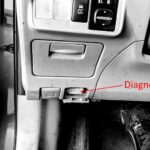For 2010 Subaru Outback owners, understanding the OBD2 port is crucial for vehicle diagnostics and maintenance. This port, a standardized feature in modern vehicles, serves as an interface to your car’s computer system. But where exactly is it located in your 2010 Subaru Outback, and what can you do with it? Let’s delve into the specifics, particularly its use for maintaining power during battery disconnection.
The OBD2 port, short for On-Board Diagnostics II, is primarily designed for accessing vehicle diagnostic information. Mechanics and car owners use code readers or scanners that connect to this port to retrieve trouble codes, monitor engine performance, and diagnose various car issues. It’s a vital tool for understanding your Subaru’s health and addressing potential problems.
Pin 16 of the OBD2 port is particularly noteworthy. It’s directly connected to the car’s battery and provides constant 12V power. This constant power supply has a less commonly known but highly useful application: maintaining your car’s computer memory when disconnecting the battery.
When you disconnect your 2010 Subaru Outback’s battery, several electronic modules lose power. These modules often store learned data that optimizes your car’s performance. Additionally, you’ll lose radio presets and clock settings. In some vehicles, the accessory power outlet remains powered even when the ignition is off, allowing for a temporary power source to prevent memory loss during battery changes. However, this isn’t the case with Subaru Outbacks; their accessory outlets are not constantly powered.
This is where the OBD2 port’s pin 16 becomes valuable. By using a 12V power source connected to the OBD2 port (specifically pin 16), you can supply power to the car’s system while the battery is disconnected. This method allows you to replace the battery without losing crucial memory settings. Many automotive service centers utilize adapters that connect a 12V source, like a jump starter, through the OBD2 port, often with a 7.5 Amp fuse for safety.
It’s essential to exercise caution when using this method. While the power draw from the car’s modules is minimal, activating other electrical components can cause problems. If you open a door and the interior lights turn on, or if any other significant electrical load is introduced, the current draw might exceed the 7.5 Amp fuse’s capacity. If this happens when the car battery is disconnected, the fuse will blow, effectively negating the memory-saving effort, and you’ll experience the same memory loss as if you hadn’t used the OBD2 port method at all. This often manifests as reset clock and radio settings, and potentially a temporarily rough idle until the engine control module (ECM) relearns its optimal parameters.
A blown fuse in this scenario is not related to check engine lights (CELs) and won’t trigger one. However, it will prevent OBD2 code readers that rely on the car’s power from functioning. If you are attempting to read diagnostic codes after a battery replacement and the reader isn’t powering on, check the fuse used in your memory-saving setup, if applicable, and also the car’s relevant fuses.
In conclusion, the OBD2 port in your 2010 Subaru Outback, particularly pin 16, provides a convenient point for maintaining power during battery disconnection. Understanding its location and function can save you from resetting your car’s settings and ensure smoother operation after a battery change. However, always proceed with caution and avoid drawing excessive power to prevent blowing the fuse and defeating the purpose of memory preservation.
